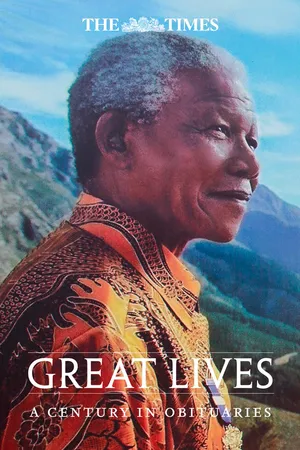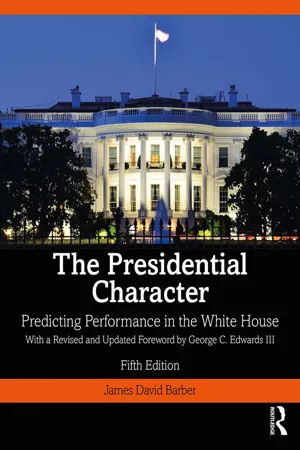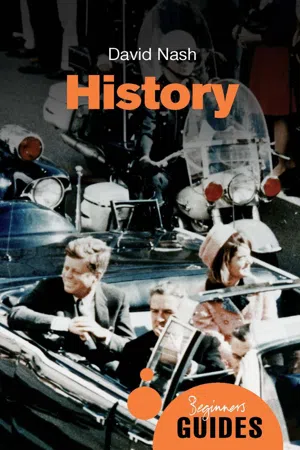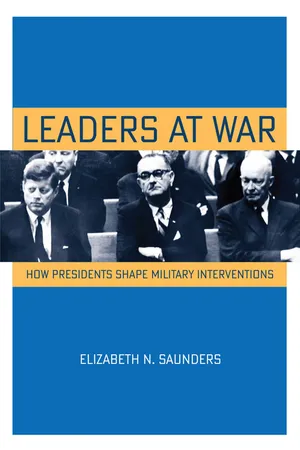History
John F. Kennedy
John F. Kennedy was the 35th President of the United States, serving from 1961 until his assassination in 1963. He is remembered for his inspirational leadership, particularly during the Cuban Missile Crisis and his commitment to civil rights. Kennedy's presidency also saw advancements in the space race with the establishment of the Peace Corps and the pledge to land a man on the moon.
Written by Perlego with AI-assistance
Related key terms
5 Key excerpts on "John F. Kennedy"
- eBook - ePub
- (Author)
- 2015(Publication Date)
- Times Books(Publisher)
President John F. Kennedy
Courage and idealism at the White House 22 November 1963President John F. Kennedy , whose assassination at the age of 46 is reported on another page, has died in the fullness of his fame. Whatever qualifications there may be about some of his detailed policies – and no man could hold that awesome office without receiving his measure of criticism – he will take his place in the roll of strong Presidents. Throughout his time in office he had major difficulties with Congress, but he was the master of his own Administration, a man of decision and nerve. Had he lived he would have remained a forceful influence on international affairs for many years to come. In that sense he was still a man of promise.President Kennedy’s years in office will always be marked with distinction, above all for his handling of the Cuban crisis. It was then that he took the supreme risk, told the American people, and indeed the free world, what had to be faced, and firmly blocked the advancing convoy which was bringing medium-range rockets to sites in Cuba, from which they would profoundly have altered the strategic balance of power. The decisiveness of United States policy at this time not only won President Kennedy an abiding place among the great Presidents of the United States but leading, as it has done, to an easing of the cold war, and last July to the nuclear test ban treaty, may well be regarded as one of the real turning-points in history.Youngest EverHe was the youngest man ever to be elected to the White House. He was the first President to be born in the twentieth century; the first Roman Catholic, and the first of purely Irish descent. He was the first since Harding to come to the Presidency directly from the Senate. But for the most part these were mere accidents of history. He happened to be a signpost to new trends in American life and politics. - eBook - ePub
The Presidential Character
Predicting Performance in the White House, With a Revised and Updated Foreword by George C. Edwards III
- James Barber(Author)
- 2019(Publication Date)
- Routledge(Publisher)
But it was in "the gift of winning public confidence and support" that Kennedy knew he would find his main thrust and challenge. Fourteen years later, as he moved on the Presidency, he reached back into his past to find a way beyond the critics' doubts.Kennedy as President
There was a gap of fourteen years. Kennedy had his ups and downs, and it would be wrong to say he did not continue to grow as Congressman, Senator, contender for the Vice Presidential nomination in 1956. But Kennedy as Presidential candidate and as President of the United States could have been anticipated; his style, world view, and character had their roots in his earlier years.The Kennedy rhetoric—only partly a matter of speechmaking—was much the same as it had been from the start, though the Presidential candidate showed a confidence in delivery well beyond his 1946 performance. But the directness, the projection of restrained rage, the intellectuality, the humor and statistics, candor and vagueness were his trademarks. He urged without preaching, inspired without condescending. And the effect on his partisans was electric. Theodore White remembers not so much the size of the crowds as their "frenzied quality." The response to Kennedy was symbolized in "the jumpers":The jumpers made their appearance shortly after the first TV debate when trom a politician Kennedy had become, in the mind of the bobby-sox platoons, a "thing" combining, as one Southern Senator said, "The best qualities of Elvis Presley and Franklin D. Roosevelt." The jumpers were, in the beginning, teenage girls who would bounce, jounce and jump as the cavalcade passed, squealing, "I seen him, I seen him." Gradually over the days their jumping seemed to grow more rhythmic, giving a jack-in-the-box effect of ups and down in a thoroughly sexy oscillation. Then, as the press began to comment on the phenomenon, thus stimulating more artistic jumping, the middle-aged ladies began to jump up and down too. .. .20The "star quality," the Kennedy "mystique" was there again. Apparently Kennedy's personal cool, his critical stance toward self-satisfaction, his call for a higher standard of performance, and his thirst for action—or some part or symbiosis of those—fit the mood of the young, and, increasingly in a culture where the young are thought to show the way, the not so young. After the television debates with Nixon, Kennedy was remembered not so much for what he said as for the impression of expertise, precision, and judgment he conveyed. - eBook - ePub
History
A Beginner's Guide
- David Nash(Author)
- 2015(Publication Date)
- Oneworld Publications(Publisher)
3 The search for ‘truth’ – establishing the facts, causes, and explanationsThe assassination of John F. Kennedy
On 22 November 1963 the president of the USA, John F. Kennedy, was assassinated whilst visiting the city of Dallas, Texas. He was shot at approximately 3 PM , in the presence of his wife and a number of his close aides and advisers, as he was travelling in a presidential motorcade.It is a salutary comment that, in the final analysis, this is all we can know for absolute certain of what actually happened to John F. Kennedy on that fateful afternoon. Almost all those who have read this far will certainly be concerned that this explanation is not complete or in any way satisfying. It does not contain important information that we would want to establish as fact or explanation, something that would enable us to analyse the events of that day with greater precision and accuracy. The need for such undisputed facts and a desire for the truth is one of the very strongest reasons that human civilization has for wanting a sophisticated and developed conception of history. Without this, simply retelling the events risks making this account nothing more than an unsatisfactory story.This search for the truth is fundamental to us in moulding our conception of how life and events are given order and made to have meaning. Thus truth, trust in the facts, and the power of interpretations are what often enable individuals to cope with the world and shape their conceptions of good and evil. History is a search for truth, even if it is sometimes approached from some very different and contrasting directions. What we perceive the truth to be (drawing on facts we know and the interpretation we favour) also shapes the narrative that we give to history. As a result, many of the ideas about history that shape our lives rest on the establishment of these facts and fundamental truths. The search for the truth, as von Ranke argued, fundamentally drives the need to give shape to history. The consequence of this is that a historian strives for the truth to ensure that the history they write has the correct shape and tells the correct story. Thus an individual history written by an individual historian seeks to portray their version of the truth as a combination of their ability to prove a series of facts and shape these into an interpretation. - eBook - ePub
Cornell Studies in Security Affairs
How Presidents Shape Military Interventions
- Elizabeth N. Saunders(Author)
- 2011(Publication Date)
- Cornell University Press(Publisher)
4John F. Kennedy
John F. Kennedy’s presidency was marked by many forms of political, economic, and military intervention. Kennedy’s interventions—including his only overt military intervention, the counterinsurgency effort in Vietnam—stand out among those of Cold War presidents for their transformative character: from Latin America to Southeast Asia, Kennedy sought to influence the domestic institutions of Third World states on a large scale. But this pattern of interference did not result from international pressure, political expedience, or idealism. Kennedy came to office with a transformative agenda already in place, the product of a consistent and unusual focus on the Third World’s domestic problems throughout his congressional career.This chapter argues that in sharp contrast to Dwight Eisenhower—and, more surprisingly, to Lyndon Johnson—Kennedy held strong beliefs that located the source of threats in the internal institutions of other states. These beliefs were reflected in his speeches and writings in Congress. Even before reaching the Oval Office, Kennedy saw not only communist regimes but also repressive anticommunist dictatorships as potentially threatening. As president, Kennedy immediately began to invest forcefully in transformative strategies.As with other presidents, however, the path from beliefs to decisions is not linear. Many commentators have pointed out that Kennedy had a strong pragmatist, even realist, streak.1 His transformative agenda did not stem merely from idealism: Kennedy believed that U.S. national security was bound up with the internal conditions of Third World states. Furthermore, though more tolerant of neutralism and “diversity” within the international system than Eisenhower,2 - eBook - ePub
US Foreign Policy and Democracy Promotion
From Theodore Roosevelt to Barack Obama
- Michael Cox, Timothy J. Lynch, Nicolas Bouchet(Authors)
- 2013(Publication Date)
- Routledge(Publisher)
6 John F. Kennedy and Lyndon JohnsonJon RoperIn 1917, the year that John F. Kennedy was born, Woodrow Wilson asked Congress to support military intervention in the First World War and to send American troops to the battlefields of Europe in order ‘to keep the world safe for democracy’. Three decades later, shortly after Kennedy first entered Congress, and when ‘Cold War’ was becoming the popular term to describe the contemporary state of American–Soviet relations, Harry Truman, the only president to have served with the American forces that Wilson sent to France, requested funding from the legislature to combat the spread of communism in Greece and Turkey. The Truman Doctrine, with its accompanying commitment to containment, defined the United States’ Cold War foreign policy. Later in 1947, in a further effort to forestall the development of the political conditions in which communism was thought to thrive, the Marshall Plan invested American aid to support those Western European economies that were struggling to recover from the impact of the Second World War.Throughout the 1950s, during Dwight Eisenhower’s administration, Cold War tensions and domestic anti-communist sentiments ebbed and flowed. In 1960, Kennedy was elected to the White House with a slim mandate for change. His administration embraced a new sense of activism, seeing the promotion of democracy abroad not simply as an end in itself, but also as vital to the preservation of the United States’ national security in the contemporary context of intensifying superpower rivalry.In the five decades that have elapsed since Kennedy’s presidency, historical assessments of his stature as a world leader and evaluations of his foreign policy have veered between extremes. Initially, the ‘Camelot historians’, principally Theodore Sorensen and Arthur Schlesinger Jr., reacted to his assassination by seeking to establish an idealistic image of Kennedy in the public mind. They focused on his rare abilities, not only in steering the nation through moments of extreme international crisis, but also in empathizing with the nationalistic aspirations of the post-colonial world.1
Index pages curate the most relevant extracts from our library of academic textbooks. They’ve been created using an in-house natural language model (NLM), each adding context and meaning to key research topics.




